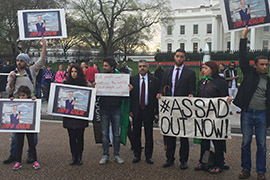- Slug: BC-CNS-Arizona Syria,800
- Photo available (thumbnail, caption below)
By Megan U. Boyanton
Cronkite News
WASHINGTON – Zaki Lababidi remembers when the Syrian community in Arizona was a close-knit group, holding social events and fundraisers to help people back home.
But now, he says, the community is feeling the chilling effects of the conflict in their native land thousands of miles away.
“You are 10,000 miles away, and you are afraid to go to an event that maybe somebody will tell the regime about,” said Lababidi, president of the Syrian American Council. “And then you and your family will be in trouble.”
The exact number of Syrians living in Arizona is not readily available, but 1,291 Syrian refugees have moved to the state since 2014, according to the State Department’s Refugee Processing Center. Only California, Michigan, Texas and Pennsylvania have taken in more Syrian refugees over that period.
Lababidi lives in Scottsdale now – an American citizen and cardiologist. He said his relatives have fled Syria as refugees, but that many Arizona Syrians still have loved ones in their home country where an insurgency has been waged against the regime of President Bashar al-Assad since 2011.
“Their wives want to go back to Syria and visit their families there,” Lababidi said. “And they have to stop anything that could be perceived that is an act against the butcher regime in Damascus.”
When it comes to criticizing the Assad administration, he said, distance does not matter.
“If they cannot get to you, then they take your relatives,” Lababidi said. “Either you have to go and give up yourself to them to release your relatives – and, sometimes, they don’t – or they kill your relatives, and you live the rest of your life with the guilt of the responsibility.”
Tucson resident Rania – a Syrian refugee – asked that her last name not be used because she shares those concerns about the safety of herself and her relatives in Syria.
“They have a wanted list,” Rania said. “My name’s not mentioned anywhere, but it’s still scary. You go there – you have no guarantee of coming back.”
She first came to the United States as a student from Damascus, the Syrian capital, and opted to stay here with her husband.
In Syria, “you cannot be free in your country,” Rania said. “So, we decided this is the place where we want to be.”
Lababidi said he grew up in the Syrian city of Homs during the 29-year rule of Assad’s father, President Hafez al-Assad. He decided to leave after his car was sprayed with gunfire by a passing regime ambulance, whose “driver thought that I slowed him down somehow.”
Still, he returned every year until 2010, when he encountered a political atmosphere that is reminiscent of the government under Hafez al-Assad.
“It was back to the father days where you cannot say a word, you cannot speak,” he said of his 2010 trip. “His (Bashar) picture’s all over the place – the usual dictatorship mentality, propaganda that we’re used to in Cuba, Russia.”
Rania also reluctantly stopped her visits to Syria about a decade ago. While she supports the ongoing “revolution,” she and her spouse both fear repercussions if they return.
Even so, Rania said Syrians in Tucson are split in their loyalty to Assad.
That same rift can be seen in Syria as well, said Hardin Lang, vice president for programs and policy at Refugees International. In a phone call from northern Iraq, he said certain areas of Syria still strongly support the government, while others have “very little love lost with the regime at Damascus.”
Lang said it’s important to remember that many Syrians “have lived under barrel-bombing and sort of the brutal tactics the Assad regime have utilized in order to regain this control.”
Violence flared unexpectedly this month when President Donald Trump announced a withdrawal of U.S. troops from northern Syria, where they have assisted Kurdish forces since 2015 in their fight against the Islamic State. Trump faced backlash from U.S. lawmakers – most notably fellow Republicans – after Turkish forces moved in to attack the Kurds, America’s erstwhile allies.
The administration sent $50 million in “stabilization assistance” funds to Syria and imposed economic sanctions on Turkey. Vice President Mike Pence was dispatched to broker a ceasefire with the Turks, leading Trump to lift the sanctions in exchange for the promise of a permanent truce.
But Lang said the negotiation has hardly brought about peace.
“Even though the ceasefire has been in place now for a little bit, fighting continues,” he said. “It’s a fairly chaotic situation.”
For Lababidi, recent events only build upon decades of struggle that long preceded the start of the Syrian Civil War.
“This is the regime that we Syrians dealt with since 1970,” he said. “This did not start in 2011. And it was equally brutal to all.”
For more stories from Cronkite News, visit cronkitenews.azpbs.org.
^__=
Web links:
_ Refugee Processing Center: https://ireports.wrapsnet.org/Interactive-Reporting/EnumType/Report?ItemPath=/rpt_WebArrivalsReports/MX%20-%20Arrivals%20by%20Destination%20and%20Nationality
_ Trump withdrawal tweet: https://twitter.com/realDonaldTrump/status/1181172457811697664
_ Syrian relief funds: https://www.whitehouse.gov/briefings-statements/statement-press-secretary-88/
_ Trump sanctions order: https://www.whitehouse.gov/briefings-statements/statement-president-donald-j-trump-regarding-turkeys-actions-northeast-syria/
_ Trump remarks on Syria: https://www.whitehouse.gov/briefings-statements/remarks-president-trump-situation-northern-syria/
^__=
Zaki Lababidi, center, a Syrian emigre who now lives in Scottsdale, takes part in an April 2017 protest outside the White House against the regime of Syrian President Bashar al-Assad. (Photo courtesy the Syrian American Council)
